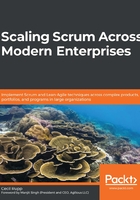
Chapter 3: The Scrum Approach
The previous chapter introduced the fundamental elements of Scrum, including the importance of executive sponsorship, putting a focus on products, forming Scrum Teams, and identifying Scrum roles and responsibilities, events, and artifacts. This section puts these concepts into play across a Sprint development cycle.
As you read through this section, please refer to Figure 3.1 – Scrum-based iterative and Incremental development cycle, which provides a graphical view of the basic flow of work within the Scrum framework. As defined in The Scrum Guide, the Scrum events that define a Scrum workflow include Sprint, Sprint Planning, Daily Scrum, Sprint Review, and Sprint Retrospective. Figure 3.1 includes additional elements not included in the Scrum Guide, but they provide useful contextual information across the Sprint cycle.
In this chapter, we're going to cover the following main topics:
Guiding the flow of work in Scrum
Initiating development work
How Scrum can break down
Identifying how Scrum can break down
Failing implementations of Scrum
Specifically, we are going to put all of the concepts you've learned in the previous chapter together to outline the basic approach to developing a product under the Scrum framework. In this chapter, you will learn how Scrum events enforce the iterative and Incremental workflows of Scrum.